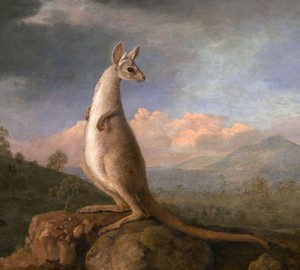
Description of the picture:
New Holland Kangaroo – George Stubbs. Canvas, oil. 60 x 71 cm
In 1771, the explorer James Cook returned to England, who discovered Australia. Among the exotic items brought by them were the skull and the skin of a kangaroo. Knowing George Stubbs as a great animal painter, the expedition member Baronet Joseph Banks invites him to paint a portrait of the animal based on these exhibits and eyewitness accounts.
Two years later, at the Royal Academy of Arts, visitors to the exhibition were first presented with a picture of an unknown animal. For the British, this was a revelation.
Thanks to the talent of the painter and his knowledge of anatomy, the animal in the picture seems alive. The kangaroo sits on its long hind legs, resting its thick tail on the ground. Short front paws pressed to the body. The animal looks back warily, large ears are strained. Expressive eyes peer into the distance with curiosity.
Thick short light gray fur of the animal glistens in the sun, along the back and tail stretches a strip of golden beige color. The coat is so carefully written and it seems so soft that you want to stroke it.
In writing the background, the artist uses soft pastel shades of gray-blue, brown and green. A cloudy sky with clouds slightly lit by the sun, mountains and trees in a haze – all this allows you to focus only on the figure of the animal. For the next fifty years, the canvas became the only model for the image of a kangaroo. He was repeatedly reprinted and redrawn.
In 2013, the British, after raising funds, managed to buy the painting from the descendants of Banks and she remained in England, in Greenwich, at the National Maritime Museum."